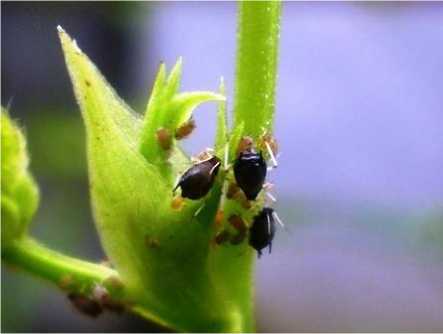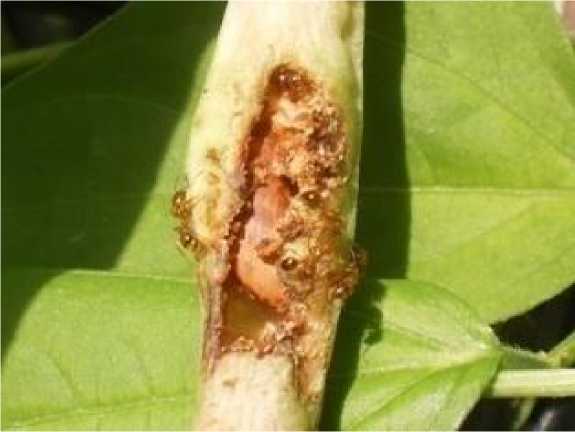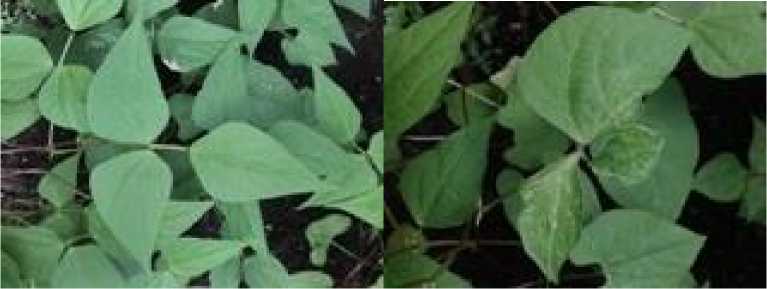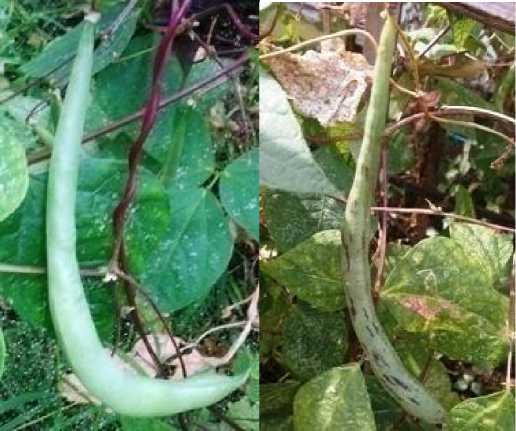INDUCED IN VIVO MUTAGENESIS USING COLCHICINE IN HYDROGEN PEROXIDE ON M2 COWPEA, YARDLONG BEAN AND COMMON BEAN
on
INTERNATIONAL JOURNAL OF BIOSCIENCES AND BIOTECHNOLOGY • Vol. 7 No. 1 • September 2019
eISSN: 2655-9994
pISSN: 2303-3371
https://doi.org/10.24843/IJBB.2019.v07.i01.p01
INDUCED IN VIVO MUTAGENESIS USING COLCHICINE IN HYDROGEN PEROXIDE ON M2 COWPEA, YARDLONG BEAN AND COMMON BEAN
I Gede Ketut Susrama* and Ni Luh Made Pradnyawathi
Agroecotechnology Department, Faculty of Agriculture, Udayana University Jl. PB. Sudirman, Denpasar, Bali 80232, Indonesia *Corresponding author: ketutsusrama@unud.ac.id
ABSTRACT
Research on doubling plant chromosome using colchicine has been carried out for years with water as its solvent. In this study, an innovation was carried out by trying to do colchicine treatment in hydrogen peroxide. In this in vivo induced mutagenesis research, colchicine in hydrogen peroxide was administered as mutagen on seeds three species of crops i.e. mutan M2 cowpea, yardlong bean, and common bean by soaking method. The results of this research showed that three times multistep mutant (M3) of cowpea was having mutant characteristics that the shape of its leaflet changed from rhombus to ovate. Besides, both yardlong bean varieties used in this research (BLR and KTR) showed indication of a mutant crop that having compound leaves with more than three leaflets in a stalk. Common bean of PTW variety was not attacked by any aphid but it was attacked by leafminer. Finally, we found “rainbow common bean” from this research.
Keywords: Mutagenesis, Colchicine, Selenopsis spp, Rainbow common bean
INTRODUCTION
Cowpea or blackeyed bean is named “Tunggak” bean or “Tolo” bean in Indonesia. This kind of bean has been consumed since the ancient time and it is still cultivated until at present besides also planted as a cover crop. Yardlong bean and common bean are in great demand in Indonesia and used to be eaten as salad or it cooked as a mixed vegetable dish.
Colchicine has been used to induced mutagenesis to produce mutant crop through chromosome multiplication resulting in larger both vegetative and generative plant organs. Dermen and Emsweller, 1961 used colchicine as chromosome multiplication agent for
polyploidization process of plants with concentration ranged 0.1-1% with water solvent or 10% water and glycerin mixture. In medicine, colchicine is used as an anti-inflammatory drug for the treatment of tophus (Dalbeth et al., 2014), Mediterranean fever and cardiovascular disease (Campbell et al. 2015). Results of our previous research showed that the effect of colchicine in hydrogen peroxide on cowpea were 1) temporary leaf change, 2) pod color change from green to purple (Susrama and Wirawan, 2017), 3) change of leaflets number per leaf stalk from three leaflets to four and five leaflets, and 4) gigas mutant cowpea, which
having larger phenotype (Susrama and Wirawan, 2018).
METHODOLOGY
All seeds of mutant M3 cowpea, yardlong bean and common bean were selected visually that showing no pest damage, uniform in size and uniform in color. This research divided into three packages. The first package was induced mutagenesis on cowpea consisted of 1) 25 seeds of twice multistep mutant cowpea (M2) treated with 0.01 percent colchicine in 3 percent hydrogen peroxide, 2) untreated 25 brown color cowpea seeds that free from cowpea mosaic virus (CPMV) incidence produced from our previous research and it tried as candidate of CPMV cowpea resistance (Susrama and Wirawan, 2018), and 3) 25 M2 cowpea seeds soaked in 3 percent hydrogen peroxide as control. All those seeds after 72 hours were then planted in Taman Harum Subvillage. The second package consisted of 1) 25 yardlong bean namely BLR (commercial certified seed trade name) yardlong variety seeds untreated, 2) 25 yardlong bean namely KTR
(commercial certified seed trade name) variety untreated, and 3) 25 yardlong bean BLR variety treated with 0.01 percent colchicine in hydrogen peroxide 3%. The three categories after 72 hours were then planted on the land that has been hoeed and made beds. The third package consisted of 1)
25 seeds of PTW (commercial certified seed trade name) common bean variety soaked in hydrogen peroxide 3% as control, 2) 25 seeds of PTW common bean variety treated with 0.005 percent colchicine in hydrogen peroxide 3%, and 3) 23 seeds of PTW common bean variety treated with 0.01 percent colchicine in hydrogen peroxide 3%. All seed categories then planted. Observation variables were leaf morphological and structural changes, pest and disease incidence, color and size of pods, and seed weight.
RESULTS AND DISCUSSION
Induced mutagenesis on cowpea
The three times multistep mutant (M3) cowpea and the cowpea variety as resistance candidate against CPMV were still showing mutant characteristic such as leaf-shaped changing from rhombus to ovate and its compound leaves having four or five leaflets, indicating that the nature of mutant is still present, means that those traits were inherited. The incidence of cowpea mosaic virus disease did not occur on CPMV resistance cowpea candidate, unfortunately, all individuals of CPMV resistance cowpea candidate in this research failed to develop flowers. Mutagen treatment reported to cause many kinds of effects on plants such as gamma rays and ethyl methanesulfonate (EMS) caused sterile pollen on sunflower (Jamhade and Kashid, 2017), on carnation (Roychowdhury and Tah,
2017), and changes in flower color (Borkar and More, 2010). Treatment of EMS and Sodium Azide affected the flowering time of Arabian bean Cicer arietinum M2 and M3 generation (Khasid and More, 2016) and Warid et al (2017) stated that gamma rays treatment on M1 generation of Anjasmoro variety of soybean could cause failure of flower formation.
Terminal leaflet’s length of cowpea M2 (5.9cm) in average was 16% longer and significant different statistically compared to terminal leaflet’s length of cowpea M3 (5.1cm) based on data at 10 days after planting (DAP) (Table 1). This result showed that multi-step colchicine effect was decreased, in other words, the effect of colchicine was better on origin variety.
Table 1. Length of the terminal leaflet (cm) at 10 DAP
|
Samples |
Candidate of CPMV resistance cowpea |
Three times multistep colchicine-treated M3 cowpea |
Cowpea M2 (Control) |
|
1 |
4.0 |
6.0 |
5.5 |
|
2 |
3.8 |
5.5 |
6.0 |
|
3 |
4.0 |
4.2 |
6.2 |
|
4 |
4.0 |
5.0 |
6.0 |
|
5 |
4.5 |
4.0 |
6.0 |
|
6 |
4.0 |
4.0 |
5.5 |
|
7 |
3.5 |
5.1 |
6.2 |
|
8 |
4.0 |
6.0 |
5.7 |
|
9 |
4.5 |
5.7 |
6.0 |
|
10 |
4.2 |
5.8 |
6.2 |
|
Average/Notation |
4.1 a |
5.1 b |
5.9 c |
|
Note: CPMV= Cowpea Mosaic Virus | |||
The pod length of cowpea M2 control or M2 second generation pod reached a length of 19.4 cm with an average length of 16.3 cm, varying between 12.0- 19.4 cm, otherwise, length of M3 colchicine treated reached 18.8 cm with an average length of 15.3 cm, varying between 11.6-18.8 cm (Table 2). In our
previous research, the length of M2 multistep cowpea reached 18 cm (Susrama and Wirawan, 2018), so the length of its pod from M2 to M3 in average increased 8 percent. However, in average the pod length of M3 (15.4cm) was 7% shorter than M2 (16.2%).
Table 2. Pod length of cowpea
|
Treatment/ Replication |
Cowpea M2 (control) |
Three times multistep colchicine-treated cowpea M3 |
|
1 |
17.0 |
18.8 |
|
2 |
18.3 |
18.2 |
|
3 |
12.4 |
13.4 |
|
4 |
14.9 |
18.0 |
|
5 |
12.0 |
16.0 |
|
6 |
13.4 |
15.0 |
|
7 |
16.5 |
17.0 |
|
8 |
17.2 |
16.9 |
|
9 |
16.4 |
16.3 |
|
10 |
17.4 |
12.5 |
|
11 |
17.2 |
12.5 |
|
12 |
16.2 |
13.0 |
|
13 |
17.9 |
15.2 |
|
14 |
17.4 |
16.0 |
|
15 |
17.0 |
11.6 |
|
16 |
18.5 |
12.1 |
|
17 |
18.0 |
15.5 |
|
18 |
14.7 |
15.4 |
|
19 |
14.2 |
15.7 |
|
20 |
13.2 |
17.2 |
|
21 |
16.4 |
16.0 |
|
22 |
19.4 |
15.7 |
|
23 |
19.0 |
12.8 |
|
Average/Notation |
16.3* |
15.3** |
The average weight of 100 seeds of M3 cowpea was 0.1 g higher than the average weight of 100 seeds of colchicine-treated multistep M3 cowpea generation, however, t-Test statistical analysis showed that average
weight of both categories was not significantly different (Table 3). This result showed that colchicine in 3% hydrogen peroxide did not increase the seed weight of cowpea seeds significantly.
Table 3. Weight of M3 gigas cowpea (100 seeds in gram)
|
Samples |
M3 cowpea control |
Multistep colchicine-treated M3 cowpea |
|
1 |
14.7 |
15.3 |
|
2 |
15.7 |
15.0 |
|
3 |
15.2 |
14.9 |
|
4 |
14.5 |
14.4 |
|
5 |
14.6 |
14.5 |
|
Average |
14.9 ns |
14.8 ns |
Note: ns=nonsignificant.
Aphid incidence on cowpea
Aphid Aphis craccivora incidence occurred on CPMV resistance candidate cowpea was started at 20 DAP (Days After Planting), six aphids on one individual crop from 22 crops observed. Aphid attack on M2 cowpea control and M3 cowpea colchicine-treated occured at 29 DAP or 9 days later. The explosion of aphid was very fast. In the second day of incidence, its population was already rather high and it might cause disruption of flowering and pod formation so at that point insecticide was treated.
Induced mutagenesis on yardlong bean
Both varieties of yardlong bean used in this research, BLR and KTR variety turned out to be mutant yardlong bean. It can be proven from the indications that: 1) changing of leaf shape from rhombus to ovate, and 2) number of leaflets in a compound leaves more
than three leaflets i.e. having four to five leaflets in a single leaf stalk. Nonmutant yardlong bean as part of legume crop should have trifoliate leaf in each of its compound leaves. Yardlong bean KTR variety that was treated with colchicine 0.005 percent started flowering at 36 DAP, while untreated yardlong bean KTR variety (Table 4), flowering at 34 DAP and longyard bean BLR variety without treatment also flowering on day 34 DAP or 2 days earlier as compared to two categories mentioned above. It showed that colchicine treatment in this research slowed flowering time. The average length of yardlong bean terminal leaflet KTR control was 0.1 cm longer than that of yardlong bean KTR treated with colchicine 0.005 percent. The average length of yardlong bean leaflet of KTR colchicine treated was both 8.8 cm. This result indicated that the effect of colchicine treatment was not seen in the length of leaflets of yardlong bean KTR variety.
Table 4. Terminal leaflet length of yardlong bean (cm)
|
Samples |
KTR variety (control) |
Colchicine-treated KTR variety |
Untreated BLR variety |
|
1 |
10.0 |
8.2 |
8.7 |
|
2 |
9.9 |
8.5 |
8.0 |
|
3 |
8.0 |
9.0 |
8.8 |
|
4 |
9.0 |
8.0 |
10.0 |
|
5 |
9.0 |
8.0 |
8.5 |
|
6 |
9.3 |
8.1 |
8.3 |
|
7 |
8.0 |
9.7 |
9.2 |
|
8 |
8.0 |
10.0 |
9 |
|
9 |
9.0 |
10.2 |
8.5 |
|
10 |
8.8 |
8.0 |
9.2 |
|
Average/Notation |
8.9 a |
8.8 a |
8.8 a |
The average length of yardlong bean pods of KTR variety, both control (64.0cm) and colchicine-treated (57.5cm) was longer than the average length of longyard bean pods of BLR variety (55.8cm). Colchicine treatment on yardlong bean KTR variety did not increase pods length. The average length
of colchicine-treated KTR yardlong bean (57.5cm) was 11 percent shorter than the average length of its control (64.0cm), showed that no colchicine effect was shown on pods length of KTR yardlong bean (Table 5).
Table 5. Pod length of yardlong bean (cm)
|
Samples |
KTR variety (control) |
Colchicine treated KTR variety |
BLR variety (untreated) |
|
1 |
65.5 |
43.0 |
57.0 |
|
2 |
54.5 |
59.0 |
56.0 |
|
3 |
58.5 |
67.5 |
50.0 |
|
4 |
51.5 |
60.0 |
65.0 |
|
5 |
63.0 |
63.0 |
32.0 |
|
6 |
64.0 |
51.0 |
56.5 |
|
7 |
77.5 |
54.5 |
72.5 |
|
8 |
77.0 |
55.0 |
60.5 |
|
9 |
56.5 |
65.5 |
65.0 |
|
10 |
72.0 |
56.0 |
43.0 |
|
Average/Notation |
64.0 a |
57.5 a |
55.8 a |
Aphid incidence on yardlong bean
The attack of aphid pests (Fig. 1) were found at 17 DAP on untreated yardlong bean KTR variety, at 25 DAP on 0.005 percent colchicine treated KTR yardlong bean veriety, whereas aphid incidence in BLR yardlong bean variety occurred at 33 DAP or 16 days later. Aphid preference difference was initially the aphids prefer KTR yardlong bean untreated, then colchicine treated KTR variety and finally BLR variety. This result showed the preference of aphid on yardlong bean KTR colchicine treated to be lower than its preference to untreated crops.

Fig. 1. Aphid incidence on untreated yardlong bean KTR variety
Aphid abundance that attacked yardlong bean BLR variety (68 aphids) was seven times lower than that of aphids
INTERNATIONAL JOURNAL OF BIOSCIENCES AND BIOTECHNOLOGY • Vol. 7 No. 1 • September 2019
attacking yardlong bean KTR variety (508 aphids). The number of BLR variety individuals attacked (14 individuals) was also four times lower than KTR variety (59 individuals). Based on the data of incidence time and aphid abundance, it was obvious that yardlong bean BLR variety has a higher resistance against aphid. Colchicine multistep treated yardlong bean KTR variety was afflicted by 269 aphids, almost two times less than on control (508 aphids). The number of crops attacked was also less, it was 37 percent
eISSN: 2655-9994 pISSN: 2303-3371 https://doi.org/10.24843/IJBB.2019.v07.i01.p01
lower than the number of aphids on control. All those data mention above is showed in Table 6. This can be used as a clue that colchicine solution in hydrogen peroxide has a promising potency to increase the resistance of cowpea against aphid.
Table 6. Aphid attacks incidence on yardlong bean
KTR variety (control)
Colchicine-treated KTR variety
Untreated BLR variety
|
Time of incidence (DAP) |
Abundance |
Number of crop attacked |
Time of incidence (DAP) |
Abundance |
Number of crop attacked |
Time of incidence (DAP) |
Abundance |
Number of crop attacked |
|
17 |
2 |
1 |
- |
0 |
0 |
- |
0 |
0 |
|
25 |
3 |
1 |
- |
0 |
0 |
- |
0 |
0 |
|
28 |
30 |
2 |
- |
0 |
0 |
- |
0 |
0 |
|
30 |
15 |
3 |
18 |
14 |
2 |
- |
0 |
0 |
|
31 |
21 |
2 |
22 |
16 |
3 |
- |
0 |
0 |
|
32 |
38 |
4 |
25 |
5 |
1 |
- |
0 |
0 |
|
33 |
11 |
3 |
26 |
6 |
3 |
- |
0 |
0 |
|
34 |
5 |
1 |
27 |
25 |
4 |
- |
0 |
0 |
|
35 |
18 |
4 |
28 |
16 |
3 |
- |
0 |
0 |
|
37 |
51 |
4 |
29 |
19 |
4 |
- |
0 |
0 |
|
38 |
28 |
3 |
30 |
16 |
4 |
- |
0 |
0 |
|
39 |
20 |
3 |
31 |
10 |
1 |
38 |
5 |
3 |
|
40 |
34 |
5 |
32 |
21 |
5 |
39 |
5 |
1 |
|
41 |
47 |
8 |
33 |
3 |
1 |
40 |
4 |
1 |
|
42 |
109 |
10 |
34 |
85 |
7 |
40 |
15 |
3 |
|
43 |
76 |
5 |
35 |
33 |
5 |
41 |
39 |
6 |
|
Average/ Notation |
508 a |
59 * |
269 b |
43 ** |
68 c |
14 *** |
Note: DAP= Days After Planting.
Fire ant incidence (Selenopsis spp)
Fire ant attack occurred at 48 DAP on untreated yardlong bean BLR variety (Fig. 2). Four pods were attacked among twenty pods observed or in the percentage of twenty. Surprisingly, fire ant did not occur both in control and colchicine-treated yardlong bean
KTR variety. As far as we know, up to now, fire ant was not an insect pest on any crop. Although it was not something common, however, the visual evidence of this research results indicated that fire ant incidence occurred on yardlong bean pods.

Fig. 2. Fire ant attack incidence on pod of untreated longyard bean BLR variety
Induced mutagenesis on common bean (Phaseolus vulgaris)
Common bean PTW variety was used as original variety, a commercial common bean that has been having a certification permit from the Indonesian Ministry of Agriculture. Common bean PTW variety was not a mutant bean based on our observations on shape and composition of its leaflets i.e. rhombic leaf shape and there were only three
leaflets in each compound leaf as other legume’s compound leaf in general. After treating with colchicine in hydrogen peroxide, malformation leaf was found (Fig. 3), either treated with a concentration of 0.01 percent or 0.05 percent colchicine solution. Those malformation leaves did not occur in all leaves of a crop, only on the initial trifoliate leaf and further trifoliate of compound leaves develop normally.

Fig. 3. Normal lealets (left) and malformed leaflets (right)
Due to colchicine solution treatment solution on PTW common bean variety, we found that six percent or three crops out of twenty sample crops produced pods with a different color i.e. light green pod with purple spots (Fig. 4). Such kind of bean is called
colored common bean pod or rainbow common bean pod. As far as we know, this kind of result was never published in any scientific journal yet and at present, the rainbow common bean is not available in the Indonesian market.

Fig. 4. Original common bean pod (left) and mutant rainbow common bean pod (right)
Colchicine solution 0.01 percent showed a positive effect on the average length of harvested dry pods and on the average number of seeds per pod, however, showed a
negative effect on seed weight (Table 7). This result was similar in some cases to the result of our previous research on cowpea that in vivo colchicine-induced mutagenesis affects
pod length and number of seeds per pod (Susrama and Wirawan, 2018).
Table 7. Length of dry pod (cm), number of seed per pod and weight of 20 seeds (gram) of PTW variety common bean
|
Treatment |
Dry pod length*) |
Longest pod*) |
Number of seed per pod*) |
Weight of 20 seeds**) |
|
Water |
12.8 a |
16.2 |
3.8 a |
3.7 a |
|
Hydrogen peroxide |
12.9 a |
17.5 |
3.6 b |
2.8 b |
|
Colchicine 0,005% |
13.1 b |
16.0 |
3.7 c |
3.5 c |
|
Colchicine 0,01% |
14.6 c |
19.0 |
5.1 d |
3.7 d |
Note: *) Average of 20 pods ; **) Average of 5 samples
CONCLUSIONS
Pest incidence on PTW common bean variety in this research was leafminer and it occurred in all crop samples since primary leaf stage until the time of dried pods harvesting. Surprisingly, there was not any aphid incidence occurred.
ACKNOWLEDGEMENTS
Authors would like to acknowledge our deeply grateful and appreciation to Udayana University Research Institution and Community Services for funding this research i.e. Udayana Featured Research (PUU-PNBP) scheme fund, fiscal year 2018. We also thanks to all colleagues and students of Agriculture and Ecological Technology Department, Faculty of Agriculture, Udayana University, who in some ways have involved in this research.
REFERENCES
Borkar A. T. and A. D. More. (2010). Induced flower color mutations in Phaseolus vulgaris Linn through physical and chemical mutagens. Adv. Biores. 1(1): 22-28.
Campbell, B. K., Teresa A. C., Alyssa K. V. and Lindsey D. B. (2015). Beyond gout: Colchicine use in the
cardiovascular patient. Hosp. Pharm. 50(10): 859-867.
Dalbeth, N., T. J. Lauterio and H. R. Wolfe. (2014). Mechanism of action of colchicine in the treatment of gout. Clinical Therapeutics 36(10): 1466-1479.
Dermen, Haig and S.L. Emsweller. (1961). The use of colchicine in plant breeding. Research Service of
Agriculture, USA.
Jamdhade P. V. and N. G. Kashid. (2017). Induced mutagenic effect of chemical and physical mutagens on pollen sterility in sunflower (Helianthus
annuus L.). Int. Res. J. Bio. Sci. 6(3): 55-57.
Kashid N. G. and More S. B. (2016). A study of effect of induced mutation on flowering of plant in M2 & M3 generations in chickpea (Cicer arietinum L.). Trop. Plant Res. 3(1): 182-185.
Roychowdhury R. and J. Tah. (2011). Chemical mutagenic action on seed germination and related agrometrical traits in M1 Dianthus generation. Current Botany 2(8): 19-23.
Susrama, I Gede Ketut and I Gede Putu
Wirawan. (2018). In vivo multistep mutagenesis induction using
colchicine on cowpea mutant 1 (Vigna unguiculata L. Walp.). Int. J. Biosci.
Biotech. 5(2): 118-123.
Susrama, I Gede Ketut and I Gede Putu
Wirawan. (2017). Crop improvement through inducing mutagenesis in vivo using colchicine on cowpea (Vignaunguiculata L. Walp.). Int. J.
Biosci. Biotech. 4(2): 85-91.
Warid, Nurul Khumaida, AgusPurwito and
Muhammad Syukur. (2017). Influence of gamma rays irradiation on first generation (M1) to obtain new promising drougt-tolerance soybean variety (In Indonesian language).
Agrotrop 7(1): 11-21.
FACULTY OF AGRICULTURE, UDAYANA UNIVERSITY • 11
Discussion and feedback